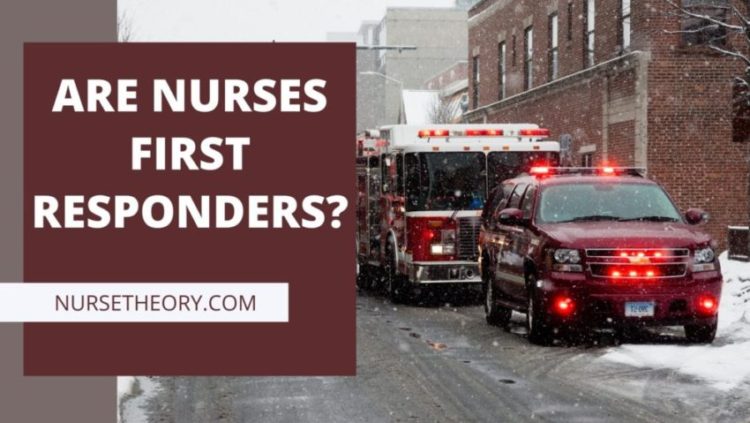
Most nurses are not first responders and do not provide care outside their medical facility.
Instead, registered nurses work at hospitals, emergency departments, nursing homes, doctors’ offices, and intensive care units.
Nurses work with first responders to provide medical care when patients arrive at a hospital or emergency department.
Some registered nurses can act as first responders in emergencies or mass casualty situations.
For instance, nurses work as first responders when a lack of EMTs, EMS, or paramedics requires additional staff to care for patients outside a healthcare setting.
Some registered nurses also provide outside care in medical emergencies, like a passenger having a seizure on an airplane.
Most registered nurses and doctors have the skills necessary to be first responders and are eligible in emergencies.
However, they’re most needed at hospitals and emergency care departments to treat patients after first responders deliver them to the hospital.
What is a First Responder?
A first responder is an individual who has received specialized training to provide first aid in emergencies.
These professionals are the first individuals to respond to an emergency and arrive at the location of the incident.
For instance, EMTs (emergency medical technicians) and paramedics arrive at the scene of accidents, natural disasters, and health situations requiring medical support.
They provide on-site emergency medical care and bring patients to a hospital or healthcare facility where they can receive advanced medical care from nurses and other healthcare professionals.
Firefighters provide emergency support where fire extinguishing, biological/chemical threats, first aid, and rescue help are necessary.
In these situations, firefighters bring fire trucks and emergency gear to extinguish fires, rescue people, and manage various biological/chemical threats.
Police officers arrive at crime scenes, accidents, physical/verbal disputes, and other situations requiring lawful assistance.
First responders with different specializations often work together to manage a crisis or emergency response.
For example, police, EMTs/paramedics, and firefighters will arrive simultaneously at stations where a building or house is on fire.
Police officers can isolate the scene while firefighters put out the fire and EMTs/paramedics treat the injured/wounded.
Each specialized first responder has numerous skills to manage and minimize the threat of various health and safety situations.
As a result, they’re essential to ensure the safety and health of their communities.
Their ability to work in connection with one another is also essential because many emergencies require various forms of assistance and aid.
Who Classifies as a First Responder?
The most well-known first responders include EMTs, paramedics, firefighters, and police officers.
With that said, there are other types of first responders that I’ll include further down.
Depending on the country, some locations have additional types of specialized units trained to manage various threats and situations.
First responders are the first people on the scene during emergencies.
In many cases, they travel to the location of the incident to provide emergency care and transport patients to a hospital or healthcare facility for advanced care.
They also work in conjunction to cover all areas of emergency support for people in need.
Types of First Responders:
- Police officers
- Firefighters
- Paramedics
- Emergency medical technicians
- Medical helicopter pilots
- Flight nurses
- Transportation security officers (TSA)
In addition, there are subdivisions and subgroups of first responders among those listed above.
It includes highway workers, state troopers, park police/rangers, sheriffs, armed security guards, and other professionals.
However, some professionals only act when existing first responders aren’t present or have insufficient staffing.
What About Flight Nurses?
Flight nurses differ from other forms of nursing because they utilize helicopters and other aircraft to arrive at the scene of an emergency.
Instead of working at a hospital or healthcare facility, these nurses operate from a helicopter providing on-the-spot medical aid to patients in need.
As a result, the majority of flight nurses are first responders.
In addition to on-site medical care, flight nurses transport patients to a healthcare facility for advanced medical care.
Although the specialized helicopter carries lots of medical equipment, it isn’t sufficient for various medical needs.
Emergency patients need an entire hospital staff with high-end medical tools, gear, and supplies.
It’s particularly true when patients require surgery or other advanced medical procedures.
Flight nurses provide care during large-scale emergencies like natural disasters, where many response vehicles are needed to care for the influx of injured individuals.
However, they also arrive at scenes where land vehicles like ambulances cannot come in time due to traffic or non-traversable terrain.
It includes large-scale accidents, mountainous terrain, floods, and cruise ships.
Why Are Most Nurses Not First Responders?
First responders are the first people arriving at an emergency scene.
These medical professionals use vehicles like ambulances, fire trucks, and police vehicles to provide on-site support.
Most nurses do not meet patients on-site or utilize transportation to arrive at an emergency.
Instead, they provide care once a patient arrives at a hospital, emergency department, or healthcare facility.
They are usually the first people patients see at the healthcare facility, while first responders are the ones who provide on-site support and take patients to a healthcare facility.
Being a first responder means actively responding to and arriving at locations requiring emergency intervention.
In most cases, nurses do not respond to these situations until patients arrive at their facility.
As a result, nurses are not the first responders in most cases.
A nurse can temporarily fill positions when there aren’t enough first responders to address particular emergencies.
In this case, a nurse may work from an ambulance or emergency vehicle to provide medical aid and ensure the patient arrives safely at a hospital or healthcare facility.